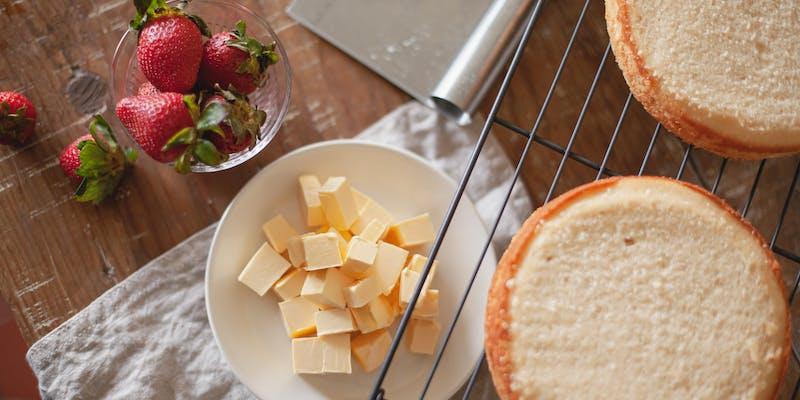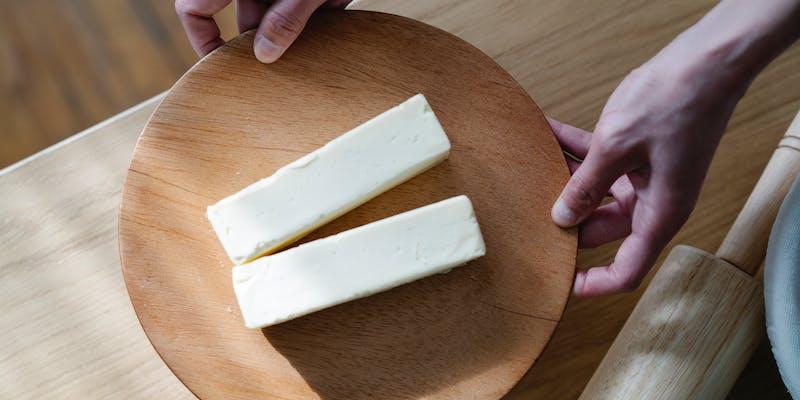Churning milk produces butter, a staple in kitchens worldwide. This process turns milk into buttermilk and solid fats. Butter can be made from sheep, goat, and buffalo milk, but we focus on cow's milk. Butter comes in salted, unsalted, grass-fed, and clarified varieties. Each type has unique ingredients and production methods. Butter's high-fat content gives it a rich flavor and velvety texture, making it a popular cooking ingredient. Butter excels in sautéing and pan-frying. It prevents food from sticking to cookware and enhances taste. Butter improves the texture and volume of baked goods and desserts.
Butter's versatility extends beyond cooking. It's a popular choice for spreading on bread and enhances the taste of various dishes, including roasted vegetables and pasta. To summarize, butter is a multifunctional dairy product, primarily sourced from cow’s milk, and finds extensive use in both cooking and baking, as well as in adding flavor to numerous dishes.
Nutritional Facts About Butter
A single tablespoon (equivalent to 14 grams) of butter contains various essential nutrients. The food item has approximately 102 calories and 11.5 grams of fat. Butter provides 11% of the RDA of vitamin A. This vitamin is essential for healthy skin, immune system, and vision. Butter also contains 2% of the RDA for vitamin E, which promotes cardiovascular health and protects cells from free radicals.
Butter is high in calories and fat but contains essential nutrients. Besides vitamins A and E, it contains trace amounts of riboflavin, niacin, calcium, and phosphorus. These elements are found in smaller quantities but are vital to health. Along with its culinary uses, butter provides essential nutrients to a balanced diet.
Benefits Of Consuming Butter

- Butter, a favorite among low-carb and high-fat diet enthusiasts, including those on ketogenic diets, offers various health advantages. Its rich, satisfying nature means a small portion can be more fulfilling than larger amounts of less enjoyable, possibly processed fat substitutes. Some of these alternatives contribute to a higher intake of calories and fats than butter and nutrition itself.
- Conjugated linoleic corrosive (CLA), a generally perceived fat particle, is a noticeable fixing in dairy and is broadly utilized as a supplement for weight reduction. Exploration recommends that CLA offers various well-being advantages, including, however, not constrained to lessening body fat, bringing down the shot of heart disease, and potentially forestalling disease. Additionally, it may be connected to valuable butter nutrition facts that impact the immune framework, guidelines of swelling, and support of bone wellbeing.
- Furthermore, a particular kind of dairy can affect its supplements. Grass-took care dairy, contrasted with dairy made from cows taken care of on grains, ordinarily contains more elevated levels of omega-3 fat particles and vitamin K2. Studies show that grass-took care dairy may have a noticeably higher measure of CLA contrasted with dairy from grain-took care of sources.
Drawbacks Of Butter Consumption
Consuming butter in typical amounts is generally not linked to significant health issues. It's essential to consider that high butter and nutrition consumption might lead to weight increase and related health concerns, particularly if one's overall diet is high in calories. Moderation is key when it comes to including butter in your diet.
- Butter contains minimal protein but enough to potentially trigger allergic reactions in individuals with a milk allergy. Limiting or completely avoiding butter is advised for those with such allergies to prevent adverse reactions.
- Butter ordinarily contains small amounts of lactose, and for this reason, in the majority of situations, the butter is lactose-free or only contains minimal quantities. Individuals might use cultured butter and clarified butter (ghee) for added caution because they have very little lactose content. Therefore, they are most often better tolerated.
- Heart disease is the biggest health butter nutrition facts problem that exists around the globe. A controversy exists on heart disease and saturated fats, such as that contained in butter. They are known to raise LDL cholesterol levels, a risk factor for heart disease. However, there are arguments that saturated fats increase the size of less harmful kinds of LDL.
How Much Butter Is Enough?
No more than 22 grams of saturated fat for a 2,000-calorie diet would equate to about 3 T (42 grams) of butter and nutrition. A more rational daily allotment would allow 1 – 2 tablespoons (14–28 grams) of butter.
The inclusion of butter in your diet ensures a well-rounded consumption of other forms of healthy fats. Other options include olive oil, nuts, seeds, coconut oil, avocados, and fatty fish. These fats offer various advantages and contribute to maintaining a balanced diet.
When selecting butter, considering its origin and the feeding methods employed for the dairy cows can impact its nutritional composition. Choosing grass-fed varieties can provide supplementary health advantages. Nevertheless, irrespective of the variety of butter, it is crucial to consume it in moderation as a component of a diverse diet abundant in various forms of beneficial fats.
Butter Alternatives

When considering alternatives to butter nutrition benefits, it's important to focus on the health benefits and culinary uses. Different substitutes serve different purposes and offer unique flavors and nutritional profiles.
Avocados
For a healthier spread on bread, avocados are an excellent choice. Rich in beneficial fats, they add a creamy texture and subtle taste. When selecting peanut butter, choosing a natural version ensures you avoid unnecessary sugars and unhealthy trans fats while providing a protein boost.
Olive Oil
Olive oil is an outstanding alternative to butter for cooking. It's particularly effective for sautéing, imparting a distinct flavor, and offering heart-healthy fats. Consider using fresh herbs instead in dishes where butter is traditionally used as a topping, such as potatoes or vegetables. Herbs like chives or tarragon provide a flavorful, calorie-free option, and a dash of lemon juice can enhance the taste further.
Jam or Jellies
Replacing butter nutrition benefits with plain jams or jellies on items like toast, pancakes, or French toast is an option for sweet spreads. However, using fresh fruits like ripe bananas or sliced strawberries offers natural sweetness and the added benefit of fiber without the extra sugar.
Non-stick Pans
If you're used to cooking eggs with butter, try a non-stick pan to reduce fat without sacrificing flavor. This simple switch allows you to enjoy your eggs without the added calories or fat from butter.

The Power of the Lunch Break: Why Skipping it is a Mistake
Jan 10, 2024

Best Healthy Late-Night Snacks
Nov 08, 2023

What is Fibromyalgia Pain and its types
Jan 15, 2024

Weight Loss Fuel: Guide to the Best Protein Shake
Jan 04, 2024

Beginner's Roadmap to Starting Cardio Workouts
Dec 18, 2023

Gluten-Free Sausages: Enjoyable Options for Breakfast and Dinner
Jan 06, 2024

7 Items You Should Add To Your Shampoo For Fast Hair Growth
Jan 03, 2024

Coconut Oil: Unveiling Its Nutritional and Health Benefits
Dec 19, 2023



